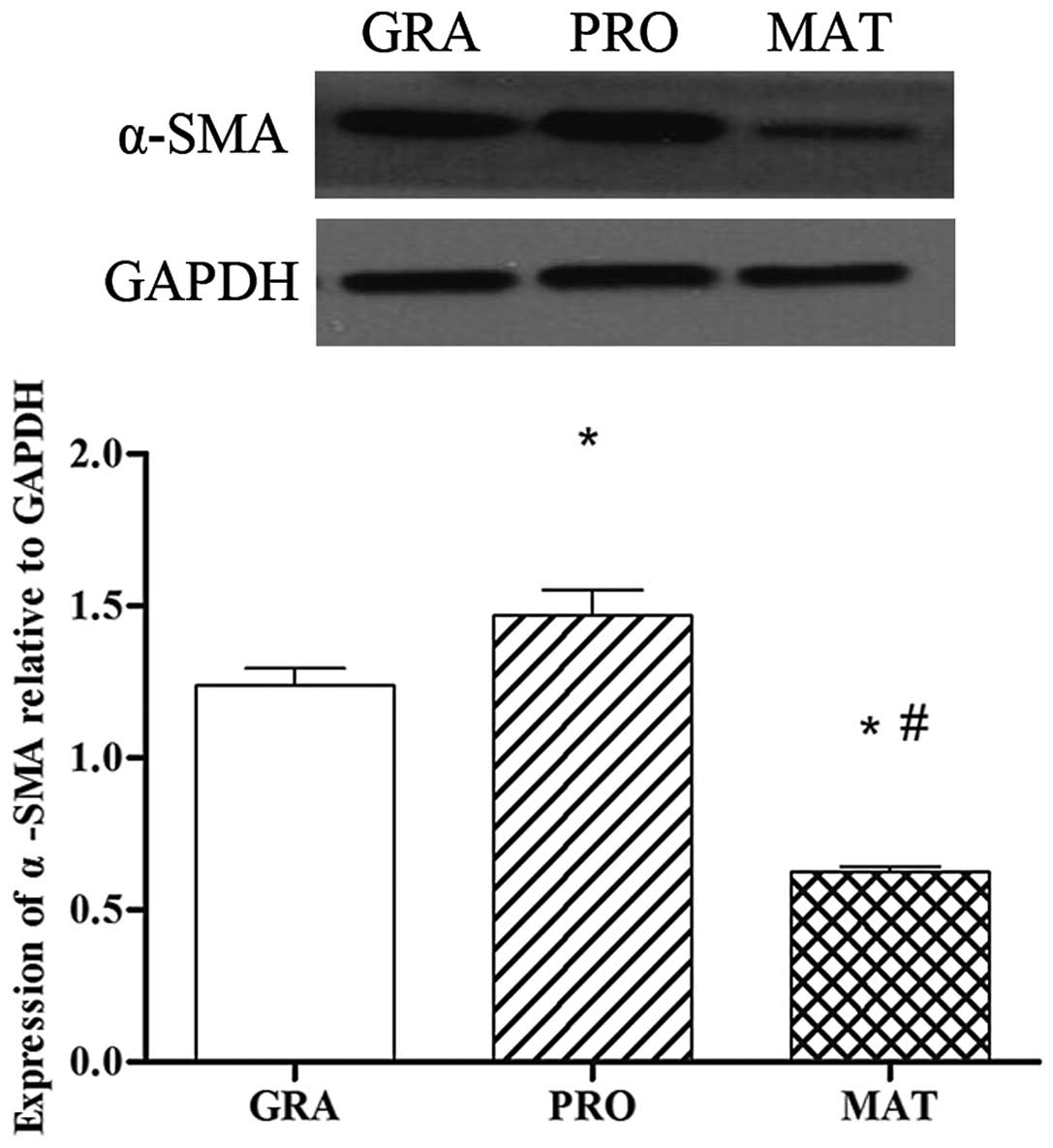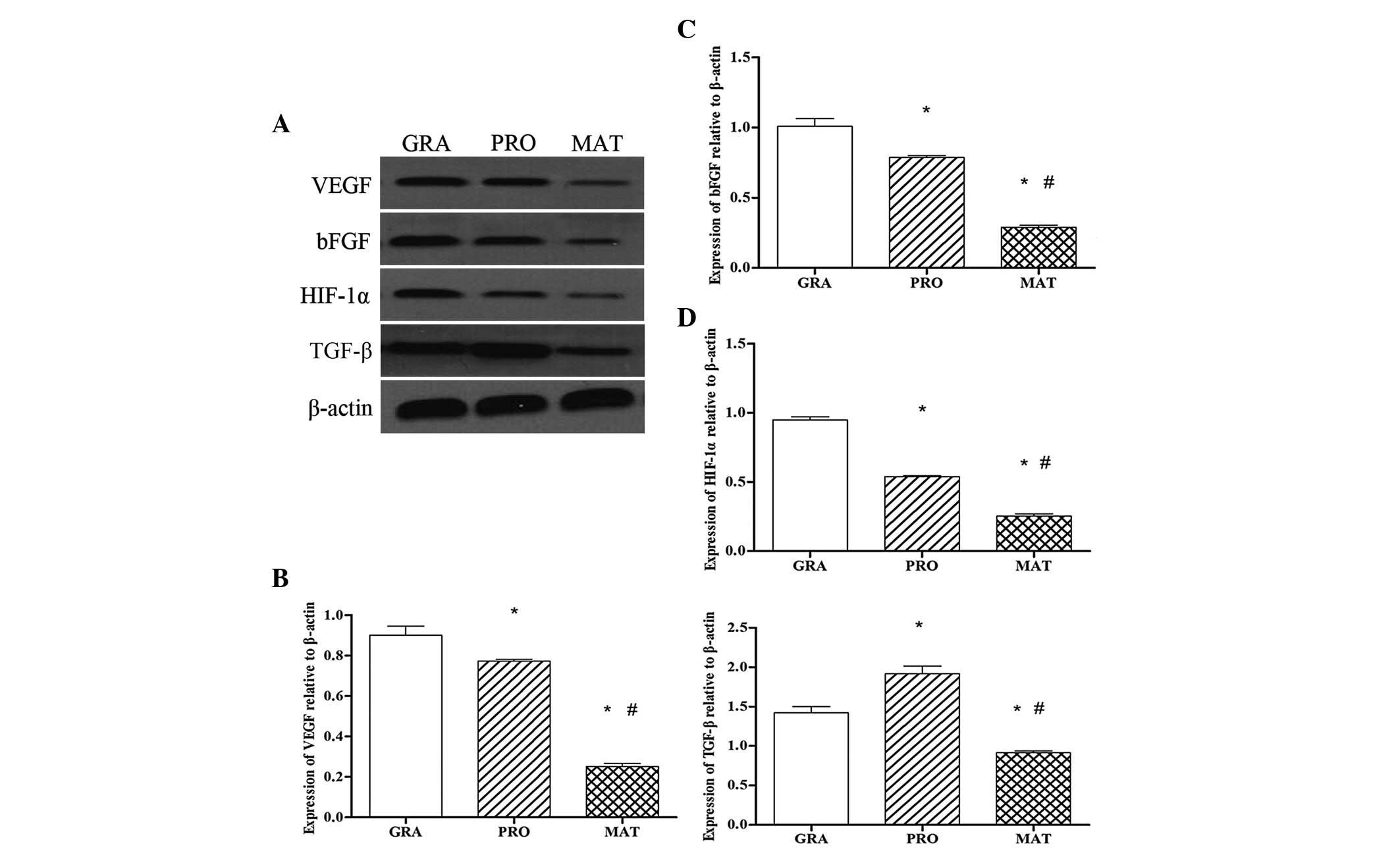|
1
|
Freitag L, Ernst A, Unger M, Kovitz K and
Marquette CH: A proposed classification system of central airway
stenosis. Eur Respir J. 30:7–12. 2007. View Article : Google Scholar : PubMed/NCBI
|
|
2
|
Wynn TA: Cellular and molecular mechanisms
of fibrosis. J Pathol. 214:199–210. 2008. View Article : Google Scholar
|
|
3
|
Dohar JE, Klein EC, Betsch JL, et al:
Acquired subglottic stenosis-depth and not extent of the insult is
key. Int J Pediatr Otorhinolaryngol. 46:159–170. 1998. View Article : Google Scholar : PubMed/NCBI
|
|
4
|
Corrêa Reis JG, Takiya CM, Lima Carvalho
A, et al: Myofibroblast persistence and collagen type I
accumulation in the human stenotictrachea. Head Neck. 34:1283–1293.
2012.PubMed/NCBI
|
|
5
|
Knowlson GT and Bassett HF: The pressures
exerted on the trachea by endotracheal inflatable cuffs. Br J
Anaesth. 42:834–837. 1970. View Article : Google Scholar : PubMed/NCBI
|
|
6
|
Cooper JD and Grillo HC: The evolution of
tracheal injury due to ventilatory assistance through cuffed tubes:
a pathologic study. Ann Surg. 169:334–348. 1969. View Article : Google Scholar : PubMed/NCBI
|
|
7
|
Jiang BH, Zheng JZ, Leung SW, Roe R and
Semenza GL: Transactivation and inhibitory domains of
hypoxia-inducible factor 1α. Modulation of transcriptional activity
by oxygen tension. J Biol Chem. 272:19253–19260. 1997.
|
|
8
|
Ohh M, Park CW, Ivan M, et al:
Ubiquitination of hypoxia-inducible factor requires direct binding
to the β-domain of the von Hippel-Lindau protein. Nat Cell Biol.
2:423–427. 2000.PubMed/NCBI
|
|
9
|
Maxwell PH, Wiesener MS, Chang GW, et al:
The tumour suppressor protein VHL targets hypoxia-inducible factors
for oxygen-dependent proteolysis. Nature. 399:271–275. 1999.
View Article : Google Scholar : PubMed/NCBI
|
|
10
|
Masson N, Willam C, Maxwell PH, Pugh CW
and Ratcliffe PJ: Independent function of two destruction domains
in hypoxia-inducible factor-α chains activated by prolyl
hydroxylation. EMBO J. 20:5197–5206. 2001.
|
|
11
|
Semenza GL: Regulation of cancer cell
metabolism by hypoxia-inducible factor 1. Semin Cancer Biol.
19:12–16. 2009. View Article : Google Scholar : PubMed/NCBI
|
|
12
|
Norman JT, Clark IM and Garcia PL: Hypoxia
promotes fibrogenesis in human renal fibroblasts. Kidney Int.
58:2351–2366. 2000. View Article : Google Scholar : PubMed/NCBI
|
|
13
|
Basu RK, Hubchak S, Hayashida T, Runyan
CE, Schumacker PT and Schnaper HW: Interdependence of HIF-1α and
TGF-β/Smad3 signaling in normoxic and hypoxic renal epithelial cell
collagen expression. Am J Physiol Renal Physiol. 300:F898–F905.
2011.
|
|
14
|
Clancy RM, Zheng P, O’Mahony M, et al:
Role of hypoxia and cAMP in the transdifferentiation of human fetal
cardiac fibroblasts: implications for progression to scarring in
autoimmune-associated congenital heart block. Arthritis Rheum.
56:4120–4131. 2007. View Article : Google Scholar
|
|
15
|
Higgins DF, Kimura K, Bernhardt WM, et al:
Hypoxia promotes fibrogenesis in vivo via HIF-1 stimulation of
epithelial-to-mesenchymal transition. J Clin Invest. 117:3810–3820.
2007.PubMed/NCBI
|
|
16
|
Nordgren IK and Tavassoli A: Targeting
tumour angiogenesis with small molecule inhibitors of hypoxia
inducible factor. Chem Soc Rev. 40:4307–4317. 2011. View Article : Google Scholar : PubMed/NCBI
|
|
17
|
Scheid A, Wenger RH, Christina H, et al:
Hypoxia-regulated gene expression in fetal wound regeneration and
adult wound repair. Pediatr Surg Int. 16:232–236. 2000. View Article : Google Scholar : PubMed/NCBI
|
|
18
|
Hiroi M, Mori K, Sakaeda Y, et al: STAT1
represses hypoxia-inducible factor-1-mediated transcription.
Biochem Biophys Res Commun. 387:806–810. 2009. View Article : Google Scholar : PubMed/NCBI
|
|
19
|
Sidgwick GP and Bayat A: Extracellular
matrix molecules implicated in hypertrophic and keloid scarring. J
Eur Acad Dermatol Venereol. 26:141–152. 2012. View Article : Google Scholar : PubMed/NCBI
|
|
20
|
Friedman DW, Boyd CD, Mackenzie JW, Norton
P, Olson RM and Deak SB: Regulation of collagen gene expression in
keloids and hypertrophic scars. J Surg Res. 55:214–222. 1993.
View Article : Google Scholar : PubMed/NCBI
|
|
21
|
Bellon G, Moreau M, Cam YJ, et al:
Modifications of collagens in the course of inflammatory tracheal
stenoses. Ann Otol Rhinol Laryngol. 94:403–408. 1985.PubMed/NCBI
|
|
22
|
Doolin EJ, Tsuno K, Strande LF and Santos
MC: Pharmacologic inhibition of collagen in an experimental model
of subglottic stenosis. Ann Otol Rhinol Laryngol. 107:275–279.
1998. View Article : Google Scholar : PubMed/NCBI
|
|
23
|
Le AD, Zhang Q, Wu Y, et al: Elevated
vascular endothelial growth factor in keloids: relevance to tissue
fibrosis. Cells Tissues Organs. 176:87–94. 2004. View Article : Google Scholar : PubMed/NCBI
|
|
24
|
Liu H, Chen JC, Holinger LD and
Gonzalez-Crussi F: Histopathologic fundamentals of acquired
laryngeal stenosis. Pediatr Pathol Lab Med. 15:655–677. 1995.
View Article : Google Scholar : PubMed/NCBI
|
|
25
|
Pokharel RP, Maeda K, Yamamoto T, et al:
Expression of vascular endothelial growth factor in exuberant
tracheal granulation tissue in children. J Pathol. 188:82–86. 1999.
View Article : Google Scholar : PubMed/NCBI
|
|
26
|
Rahbar R, Brown LF, Folkman J, et al: Role
of vascular endothelial growth factor A in children with acquired
airway stenosis. Ann Otol Rhinol Laryngol. 116:430–435. 2007.
View Article : Google Scholar : PubMed/NCBI
|
|
27
|
Wu Y, Zhang Q, Ann DK, et al: Increased
vascular endothelial growth factor may account for elevated level
of plasminogen activator inhibitor-1 via activating ERK1/2 in
keloid fibroblasts. Am J Physiol Cell Physiol. 286:C905–C912. 2004.
View Article : Google Scholar : PubMed/NCBI
|
|
28
|
Yang GP, Lim IJ, Phan TT, Lorenz HP and
Longaker MT: From scarless fetal wounds to keloids: molecular
studies in wound healing. Wound Repair Regen. 11:411–418. 2003.
View Article : Google Scholar : PubMed/NCBI
|
|
29
|
Suehiro A, Hirano S, Kishimoto Y, Tateya
I, Rousseau B and Ito J: Effects of basic fibroblast growth factor
on rat vocal fold fibroblasts. Ann Otol Rhinol Laryngol.
119:690–696. 2010.PubMed/NCBI
|
|
30
|
Barrientos S, Stojadinovic O, Golinko MS,
Brem H and Tomic-Canic M: Growth factors and cytokines in wound
healing. Wound Repair Regen. 16:585–601. 2008. View Article : Google Scholar : PubMed/NCBI
|
|
31
|
Powers CJ, McLeskey SW and Wellstein A:
Fibroblast growth factors, their receptors and signaling. Endocr
Relat Cancer. 7:165–197. 2000. View Article : Google Scholar : PubMed/NCBI
|
|
32
|
Wagatsuma A, Kotake N and Yamada S:
Spatial and temporal expression of hypoxia-inducible factor-1α
during myogenesis in vivo and in vitro. Mol Cell Biochem.
347:145–155. 2011.
|
|
33
|
Distler JH, Jüngel A, Pileckyte M, et al:
Hypoxia-induced increase in the production of extracellular matri-x
proteins in systemic sclerosis. Arthritis Rheum. 56:4203–4215.
2007. View Article : Google Scholar : PubMed/NCBI
|
|
34
|
Sogabe Y, Abe M, Yokoyama Y and Ishikawa
O: Basic fibroblast growth factor stimulates human keratinocyte
motility by Rac activation. Wound Repair Regen. 14:457–462. 2006.
View Article : Google Scholar : PubMed/NCBI
|
|
35
|
Brahimi-Horn C and Pouyssegur J: The role
of the hypoxia-inducible factor in tumor metabolism growth and
invasion. Bull Cancer. 93:E73–E80. 2006.PubMed/NCBI
|
|
36
|
Chang JH, Han KY and Azar DT: Wound
healing fibroblasts modulate corneal angiogenic privilege:
interplay of basic fibroblast growth factor and matrix
metalloproteinases in corneal angiogenesis. Jpn J Ophthalmol.
54:199–205. 2010. View Article : Google Scholar
|
|
37
|
Bos R, van Diest PJ, de Jong JS, van der
Groep P, van der Valk P and van der Wall E: Hypoxia-inducible
factor-1α is associated with angiogenesis, and expression of bFGF,
PDGF-BB, and EGFR in invasive breast cancer. Histopathology.
46:31–36. 2005.
|
|
38
|
Kottmann RM, Kulkarni AA, Smolnycki KA, et
al: Lactic acid is elevated in idiopathic pulmonary fibrosis and
induces myofibroblast differentiation via pH-dependent activation
of transforming growth factor-β. Am J Respir Crit Care Med.
186:740–751. 2012.PubMed/NCBI
|
|
39
|
Distler JH, Jungel A, Pileckyte M, et al:
Hypoxia-induced increase in the production of extracellular matrix
proteins in systemic sclerosis. Arthritis Rheum. 56:4203–4215.
2007. View Article : Google Scholar : PubMed/NCBI
|
|
40
|
Leigh JM and Maynard JP: Pressure on the
tracheal mucosa from cuffed tubes. Br Med J. 1:1173–1174. 1979.
View Article : Google Scholar : PubMed/NCBI
|
|
41
|
Lewis FR Jr, Schiobohm RM and Thomas AN:
Prevention of complications from prolonged tracheal intubation. Am
J Surg. 135:452–457. 1978. View Article : Google Scholar : PubMed/NCBI
|
|
42
|
Lee JW, Bae SH, Jeong JW, Kim SH and Kim
KW: Hypoxia-inducible factor (HIF-1)α: its protein stability and
biological functions. Exp Mol Med. 36:1–12. 2004.
|
|
43
|
Powis G and Kirkpatrick L: Hypoxia
inducible factor-1α as a cancer drug target. Mol Cancer Ther.
3:647–654. 2004.
|
|
44
|
Leask A and Abraham DJ: TGF-β signaling
and the fibrotic response. FASEB J. 18:816–827. 2004.
|
|
45
|
Liu W, Wang DR and Cao YL: TGF-β: a
fibrotic factor in wound scarring and a potential target for
anti-scarring gene therapy. Curr Gene Ther. 4:123–136. 2004.
|
|
46
|
Blobe GC, Schiemann WP and Lodish HF: Role
of transforming growth factor β in human disease. N Engl J Med.
342:1350–1358. 2000.
|
|
47
|
Karagiannidis C, Velehorschi V,
Obertrifter B, Macha HN, Linder A and Freitag L: High-level
expression of matrix-associated transforming growth factor-β1 in
benign airway stenosis. Chest. 129:1298–1304. 2006.
|
|
48
|
Higgins DF, Kimura K, Iwano M and Haase
VH: Hypoxia-inducible factor signaling in the development of tissue
fibrosis. Cell Cycle. 7:1128–1132. 2008. View Article : Google Scholar : PubMed/NCBI
|
|
49
|
Copple BL: Hypoxia stimulates hepatocyte
epithelial to mesenchymal transition by hypoxia-inducible factor
and transforming growth factor-β-dependent mechanisms. Liver Int.
30:669–682. 2010.PubMed/NCBI
|
|
50
|
Chen Z, Zhang D, Yue F, Zheng M, Kovacevic
Z and Richardson DR: The iron chelators Dp44mT and DFO inhibit
TGF-β-induced epithelial-mesenchymal transition via up-regulation
of N-Myc downstream-regulated gene 1 (NDRG1). J Biol Chem.
287:17016–17028. 2012.PubMed/NCBI
|












